Category: Uncategorized
In Class Loop – Autumn and Rylan
Breaking Space – Autumn
Rylan Eisenhauer Blog Post #4 (Chat GPT Video Chat)
When first starting my dialogue with ChatGPT I realized how important wording my prompts was. My first ask was involved saying how I was gonna use AI to create video but ChatGPT read that as “give me ideas that would make videos about AI.”
I ended up using the prompt “give me some ideas for some short film projects/ story ideas” which definitely helped get more on the right track with creative endeavors. ChatGPT gave me 10 ideas. The 3 I liked most were “Fading Memories,” “The Last Passenger,” and “Echoes of the Past.” I decided to expand upon “Fading Memories” as it seemed a route that would work well with AI being almost a dreamlike state where what is generated is allowed to be a bit odd because it may not be remembered correctly.
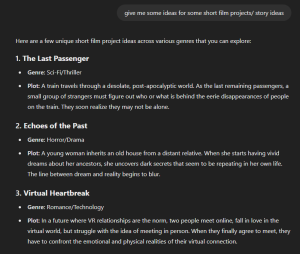
I expanded on this idea with the prompt “Hey I like that “Fading Memories” idea! I want to do a 30-60 second short film montage with me having dialogue over assortment of hazy memories. what types of shots should I consider for this project?” to which it gave many ideas that I liked with having a mixture of shorts both of the past memories being hazy and close up dramatic slow shots to create a similarity and contrast of sad feelings between both shot types.
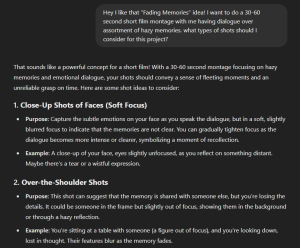
Thus I have landed on the idea to make a dramatic 30-60 second short film of happy memories slowly fading as they have happened so long ago. I will most likely make it about a love relationship that has been lost to time and being separated has made the emotion of the memories feel bittersweet. I want to have myself do the dialogue, record myself as the character in the non memories section and then use AI for all of the hazy dream sections.
To compare what I am envisioning to other works of film and quality type, the lighting of the shots of the man alone with be very dark and the AI memories will be black and white to show a positive yet slightly forgetfulness. The set for the alone man will be places like sitting on the bed, looking in the mirror, and other dramatic dark locations with the lights off meanwhile the shots of AI will be more outside and open with sunlight or good indoor lighting.
The AI creations will be similar to the montage we see at the beginning of Up (except not cartoon looking and using black and white instead) I see why they have the color in Up as Carl’s memory is fine and stable, but for my effect I need things to not have all of the details like a part of you is trying to keep it and the other wants to throw it away.

(But black and white with hazy effects)
Another point to draw from is the film “A Man Called Otto” which I believe shows both how I want to shot the in real life shots similar to Otto in his home being dramatized with different close ups and establishing shots, but also how the hazy memories are done in the montage style(except black and white instead of yellow) The yellow of these shots show pure untainted happiness about those memories meanwhile I believe the black and white effect will help show the sadness that has been added to the memories.
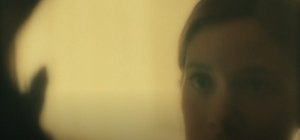
(But black and white)
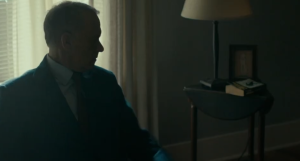
(Darker lighting but similar vibes of this)
-Rylan Eisenhauer
Rylan Eisenhauer DTC 491 Loops All 3 Videos
Here are my loop videos for the Loops Assignment. each one repeats 3 times
Continuity Loop (7 secs)x3:
Infinite Loop (8.6 secs)x3:
Montage Loop (6.3 secs)x3: (No Sound)
-Rylan Eisenhauer
Rylan and Lyndsey Montage in class video
In Class Montage – Autumn Sterle
Make Space – Autumn Sterle
Gebhart Emma Blog Post 2- Brumes d’automne (Autumn Mists)
This film uses many shots of nature, such as leaves, rain, trees, and a body of water. It also has shots of a chimney with smoke. These shots are split by shots of a woman reading a letter and being very sad. These shots of the woman are the only linear part of the film, meaning there are actions and direct cause and effect between scenes rather than a static shot of water. That being said, the “nonsensical” shots of nature give us an insight into what the woman is experiencing and feeling. Through tone the audience can infer that she is feeling very sad and hopeless. Both the shot of the woman and the shots of nature are needed for communicating this, as without the woman the audience would not have anything to tie these shots to narratively, and without the nature scenes the audience would not have a reference for what she is feeling, which is suicidal. The film reinforces this idea of using symbolic footage to represent feeling, which is more difficult to communicate than say text, by using the sun to represent her shift in perspective and mood. I would say this approach to montage is successful, as it is a creative way to communicate complex character motivation through film, and shows us visually through symbolism what she is feeling. The use of montage aids to this clear communication, as it ties the woman and the nature scenes together.
Gebhart Emma Break Space Project 3 DTC 391
For this assignment I tried to use intellectual montage and tonal montage. The concept is someone setting the table, with different perspectives of dishes. I wanted to play with different ways dishes could be shot compositionally, thus I took a more abstract direction with this project. This morphed into someone setting a formal table setting for two, only to be alone at the end with only one glass representing a desire for connection and community that is lacking in this character’s life.
Gebhart Emma In Class Montage Assignment DTC 491
Here is the final edit of the footage gathered in class for the In Class Montage Assignment. I worked with Quinn, and our idea was to communicate the feeling of being stressed out for an exam by using clocks as a theme. I also added a clock ticking noise in the background to further communicate the theme of time.
Gebhart Emma Make Space Project 2 DTC 491
For this project, I wanted to create a short film that followed continuity of a lady making coffee and reading a book. As she reads the book, the set continuity changes. The consistency, continuity, and repetition brings more attention to the fact that details are being changed from shot to shot.
‘lunar new year’ – breaking space montage
Rylan Eisnehauer DTC491 Breaking Space Video
The breaking space style I went for was using the Metric montage style with every video being exactly 3 seconds long. the Metric style ensures that editing follows a specific number of frames, duration of shot. This gives the montage a light rhythmic visualization while the near silent ambience of the room helps create the calm and relaxed vibe.
The calm and relaxing vibe I aimed towards was filming all of the different features and décor that is within my recording room. There is no sound besides light whirring of fans and brushing up against its elements to convey the importance of the items creating their own visual experience of the room. The room has many objects from posters, plushies, and gaming equipment to showcase the variety of interests while also showing the liveliness of the room also depends on the energy its given. When the main overhead light is off but the LED’s are on, you get a sense of motion and living from all of the motionless objects.
Rylan Eisenhauer Blog Prompt #3 (Time Frames, by Scott McCloud)
Right off the bat, McCloud gives the reader strong examples of how our focus on the frame and the properties it holds helps the viewer fill in blanks and create a sense of time when reading multiple parts of dialogue in a single frame. Time doesn’t stay consistent specifically based on singular properties of a frame. Rather, it is comprised of the sizing of the frame, how much dialogue, what is being captured in the frame, and even the detailing often having the audience spend more time looking at the quality of the art to imply impact.
Take for example the first example McCloud gives that involves a wide spread of characters speaking but there is a series of events and timing that helps create a sense of flow. Starting on the left the man takes a picture, the guy who gets his picture taken reacts, due to that reaction a women discourages the picture taker, then another women responds to her saying that he is fine doing so, then a man responds to the fact that he is being encouraged and encourages other behavior, and lastly the man on the right acknowledges his remarks and encourages as well.
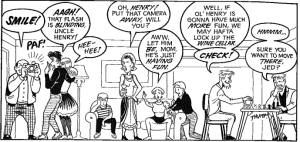
When first looking at this scene, my first initial thought is that all of these pieces of dialogue happen at the same time, because visually they ARE being presented at the same time. But it’s because of the content of what they are saying and who they are speaking to that creates a order of operations rather than a chaotic “everyone is speaking at the same time.” So now we have gotten a sense of space where everyone is and established interactions with one another as a quick judge of character. What was done in one frame is a shot that would most likely last around 15-20 seconds panning from character to character as the audience focuses on the next person.
The best connection that McCloud makes is how the rope being stranded from one dialogue bubble to the next. We can see that the flow of the events have to happen in a certain order otherwise the dialogue they provide wouldn’t match up with a different character such as one character saying “Oh Henry, put that camera away will you?” and the next saying “hmmmm, you sure you want to move there Jed?” It just doesn’t make sense!
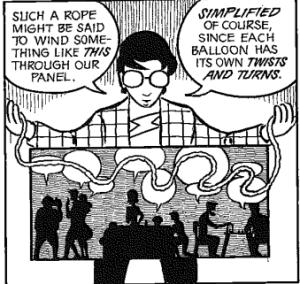
The other point McCloud made that stuck out to me is the frame shaping and its placement with the other frames. We in our culture read from left to right top to bottom so following this flow is pretty important, but that doesn’t mean we are completely restricted to this or how these frame are expressed individually or in a sequence. Some frames use 2 frames overlayed to often emphasis a certain aspect of a frame such as a zoom in or extra dialogue that happens within the same scene. These overlay frames can be place almost anywhere overtop as long as the writer can express what is happening in the background frame in relation to the one overtop.

Last point I want to talk about is panel sizing and framing within the shot size. Frame sizing often implies stronger importance on frames that are bigger when there are more details or aspects that the author wants the reader to pick up on. This is best explained in the “I guess” comic McCloud refers to, as it helps us create a sense of time between first dialogue and the next. Looking at the 2 examples below:
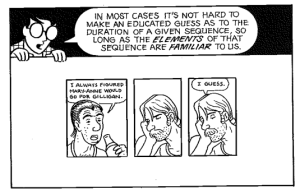

The first example shows a moment of thought, its brief but still exists within the timeline. But look at the size and framing of the second example, it shows deeper more well thought out thinking, they even make him a bit smaller in the scene so that both himself and the shot have gained new perspective. Not to mention that the frame zooming back in also creates a sense of impact to admitting the “I guess” to show that he put more thought into it verses the first example.
-Rylan Eisenhauer
consider the framed panel in a comic as a cinema shot. Wider or longer panels are like shots with longer durations (“long takes”). Smaller panels are like shots of shorter durations. Discuss some aspect of McCloud’s visual essay that makes you think of the possibilities of time manipulation in digital cinema or of a certain movie scene that plays with time.